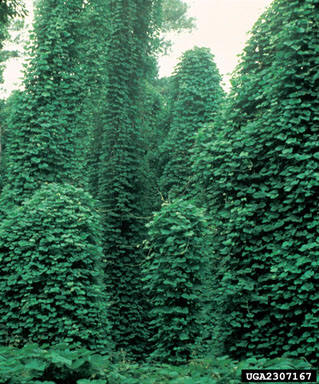
Plant: Kudzu (Pueraria montana, formerly P. lobata and P. thunbergiana) is a twining, trailing, and mat-forming woody vine native to Asia.
Identification: Stems are woody vines up to 10 inches in diameter reaching 100 feet long. Vines trail or climb with frequent branching by twining on objects less than 4 inches in diameter. Young stems are yellow-green with dense erect golden hairs and upward matted silver hairs. Stems age to rope-like, light gray hairless vines that eventually transform to rough, rigid, and usually dark-brown vines. The three-leaflet leaves and small vines are deciduous, generally dying with first frost. Large semi-woody tuberous roots can reach to depths in the soil of 3 to 16 ft. Long, pea-like fragrant flowers with lavender to wine-colored petals exist from June to September. Dry, flattened legume pods 1.2 to 3 in long are green, ripening to tan with stiff golden brown hairs. Pods eventually split to release a few ovoid seeds.
Ecology: Kudzu, a leguminous nitrogen fixer, occurs in old infestations, along rights-of-way, forest edges, and stream banks. It colonizes by vines rooting at nodes. It also spreads by dispersed seed from wind, animals, and water. Seed viability varies depending on habitat and region.
Herbicide Control: Thoroughly wet leaves using a 10.2% active ingredient of picloram herbicide (Tordon 101 or Grazon P+D) as a 3% solution (12 ounces per 3-gal. mix) in water or a 24+% active ingredient of picloram herbicide (Tordon K) as a 2% solution (8 ounces per 3-gal. mix) in water with a surfactant (methylated seed oil, basal oil, or vegetable oil) at a 1% solution (4 ounces per 3-gallon mix) anytime from June to October. Apply a 60% active ingredient metsulfuron methyl herbicide (Escort or Escort XP) at 3 to 4 ounces per acre (0.8 to 1.2 dry ounces per 3-gal. mix) in water with a surfactant at a 1% solution to foliage from July to September. If damage to surrounding vegetation is a concern, apply a 40+% active ingredient of clopyralid herbicide (Transline or Clean Slate) as a 0.5% solution (2 ounces per 3-gal. mix) in water with a surfactant at 1% solution from July to September. A 41% active ingredient of glyphosate herbicide (Accord, Razor, or Roundup Original) or a 60+% active ingredient of triclopyr herbicide (Garlon 4, Remedy, or Tahoe 4E) as a 4% solution (1 pint per 3-gal. mix) in water with a surfactant at 1% solution can be used during the growing season. Spray foliage of climbing vines as high as possible. A triclopyr herbicide at 60+% active ingredient can be used for basal spray application and a picloram herbicide at 10.2% active ingredient can be used for stem injection application. Repeated applications in successive years are necessary.
Warning: The active ingredients of picloram, clopyralid, and metsulfuron methyl can damage plants with roots in the treated area. Always read and follow label instructions carefully. Picloram herbicides are “Restricted Use Pesticides”.
Photo and Text Credit: (A Field Guide for the Identification of, A Management Guide for) Invasive Plants in Southern Forests, James H. Miller, USDA Forest Service, 2010, ForestryImages.Org
Additional Resources